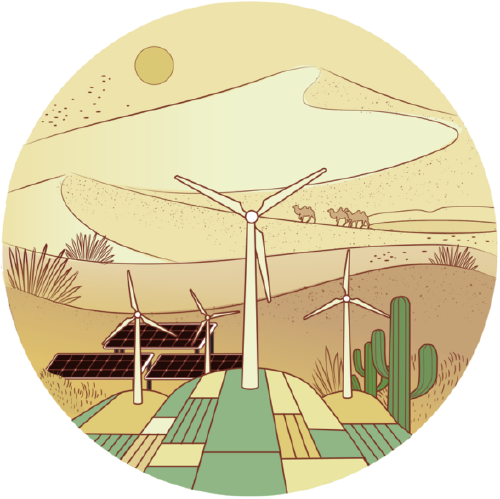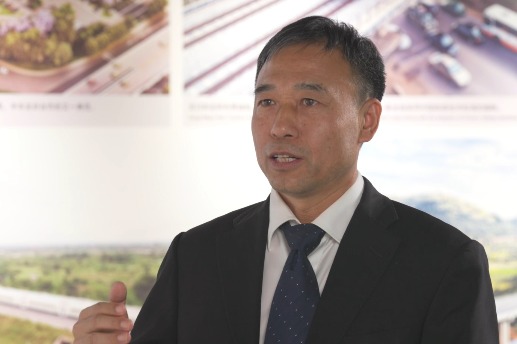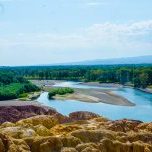By ERIK SOLHEIM | China Daily Global

Newly formed Desert Ecological Technology Alliance takes its inspiration from the greening of the Kubuqi Desert in Inner Mongolia
The greening of the Kubuqi Desert in the Inner Mongolia autonomous region is among the greatest environmental achievements of our times. Through hard and smart work, the people of Kubuqi transformed the “Sea of Death” into a lush oasis. Now that “Kubuqi spirit” will be guiding a new international organization, the International Desert Ecological Technology Alliance, which was formed this month in Beijing.
A new whopping investment of 80 billion yuan ($11 billion) is now planned in green energy in Kubuqi. This will be the biggest investment in renewable energies ever in a desert area.
The alliance is a partnership between Elion Resources Group, the Secretariat of the UN Convention to Combat Desertification, China State Power and 40 other founding member organizations, research institutions and companies.
It will help share technologies, ideas, expertise and investments between dry areas in China, Central Asia, the Middle East, Africa and beyond. A yearly forum will be hosted in Kubuqi. Demonstration bases are to be set up in 10 countries on different continents.
The new desert alliance will be rooted in “the Kubuqi spirit”.
The Kubuqi Desert is situated in the Ordos prefecture of Inner Mongolia. In the mid-Qing Dynasty (1644-1911), slash-and-burn farming resulted in the disappearance of vegetation cover and in the desertification of pastures and grasslands. The area became known as the “Sea of Death”. Up until two decades ago, the Kubuqi Desert, the seventh-largest in China, contributed significantly to the sandstorms in Beijing and Hebei.
Yet the first time I visited Kubuqi, I was struck by such a green oasis full of life and greenery in the midst of extremely dry surroundings. It was moving to see how the efforts of thousands of Chinese have been able to turn what was once a very dry desert into an enormously appealing place abundant with different forms of life.
I have visited many deserts in Africa, Latin America and the Middle East. I am not aware of any success story as impressive as Kubuqi. For sure, people on different continents have been able to green deserts, but the size and the grit of Kubuqi still stand out.
What was the secret to its success?
When I spoke to people, it turned out there was no secret. It was just hard and smart work. It was the perseverance of people who put in years of continuous efforts to achieve this great result. It was the innovative spirit of the Elion Group pioneering new approaches, relying upon public-private partnerships involving the local residents.
Wang Wenbiao was the key figure in giving this barren land a green soul. Feeling a strong emotional bond to the desert where he was born, he proved one thing: Take good care of Mother Earth, and she will take good care of you and your people.
In 1988, 29-year-old Wang took over a saltworks in his home district. The top challenge facing the factory was an expanse of sand driven by endless sandstorms that kept creeping in around the salt lake where production was based. He and his fellow men worked laboriously and painstakingly to try out all types of methods to improve life and production, including building a road, taking a portion of earnings to finance sand control and assigning a significant portion of the factory’s workforce to plant trees.
They didn’t get everything right from the beginning. But they learned from their mistakes and gained experience. The once-young idealist Wang became a major business leader known for his charismatic ability to inspire people.
Early on they understood that only a private company could help generate commercial value from the desert. It was in line with the opening-up policy of China from the 1980s onwards. It was based on a very clear understanding that over time, you cannot bring people out of poverty through handouts, or transform a harsh landscape just by being altruistic. You need an approach that creates value to make people rich while taking care of the desert. His company Elion became a sand-control pioneer.
In 2017, I had the privilege to honor Wang with the United Nation’s highest prize for the environment, the UN Champions of the Earth. It was an award for a lifetime of leadership in green industries.
At the core of the “Kubuqi spirit” is the idea that a desert is not a threat but an opportunity for economic growth and poverty alleviation. The essence of the “Kubuqi spirit” is to merge the ecology and economy into the win-win proposition that you create value and jobs from the desert, and you do it by going green.
The Kubuqi miracle has been linked to three sources of income for people in the desert.
The first originates in the enormous space in the desert, which is suitable for renewable energy. It has been used in Kubuqi to host huge solar farms. It’s beautiful to see dry landscapes used in this way to create energy which can bring up more water for agriculture, and which can power homes, and electric cars and buses.
Now a massive new phase of renewable energy in Kubuqi has been initiated in a partnership between Elion, Three Gorges Group and others. Around 80 billion yuan ($11.86 billion) is to be invested in a program of 8 gigawatt solar, 4 gigawatt wind and 4 gigawatt upgraded coal, along with energy storage, to adjust for peak demands. This will provide a massive injection of green electricity to Beijing, Tianjin and Hebei province.
The second is to grow products which can survive and thrive in dry places. Elion’s liquorice plantations are known as a “sweet deal” for the company, the growers and the environment. Elion gets a quality cash crop. Local households benefit from technical expertise and guaranteed sales. The environment benefits from the natural nitrogen fixation and soil improvement properties of the plants.
Tourism is a third source of income. Tourism is probably now the biggest job creator in the world. Kubuqi is a beautiful place not very far from population centers in Inner Mongolia and neighboring provinces. I took my teenage son to Kubuqi, and he was astonished by all the leisure opportunities there — to go camping in the desert, riding on camels and horses, and, for a teenager perhaps most temptingly, to ride race cars in the desert. There are beautiful hotels which serve great Chinese and Mongolian cuisines, for instance, traditional Mongolian lamb with vegetables from the desert.
From plantations and tourism to solar energy, the benefits of a whole range of activities have already restored more than one-third of the Kubuqi Desert and lifted over 100,000 farmers out of poverty.
These huge achievements in Inner Mongolia are exactly what President Xi Jinping seeks to encapsulate when he says that lucid waters and lush mountains are invaluable assets. Or green is gold.
The US space agency NASA recently published a report saying that, contrary to what many people think, the surface of our small planet is greener than it was in the past. And that is largely thanks to tree planting in China, in Kubuqi, and also in the Xinjiang Uygur autonomous region, Gansu province, Hebei province and other parts of the country. This is a great service to China and to humanity.
The Desert Ecological Technology Alliance is an exciting initiative, which will provide a platform for the world to be inspired by the Kubuqi spirit and to exchange views and learning between desert areas in all corners of the world.
The author is president of the Belt and Road Initiative Green Development Institute and former executive director of the United Nations Environment Programme. The author contributed this article to China Watch, a think tank powered by China Daily.
CartoonsCOVID-19 impact act eases as cases declineWorld’s top 10 most valuable brandsChina’s January box office exceeds 10b yuanChina starts 2023 with high quality developmentChina’s top 10 VR/AR innovative companies in 2022

Editor chenxuefei7@hotmail.com


